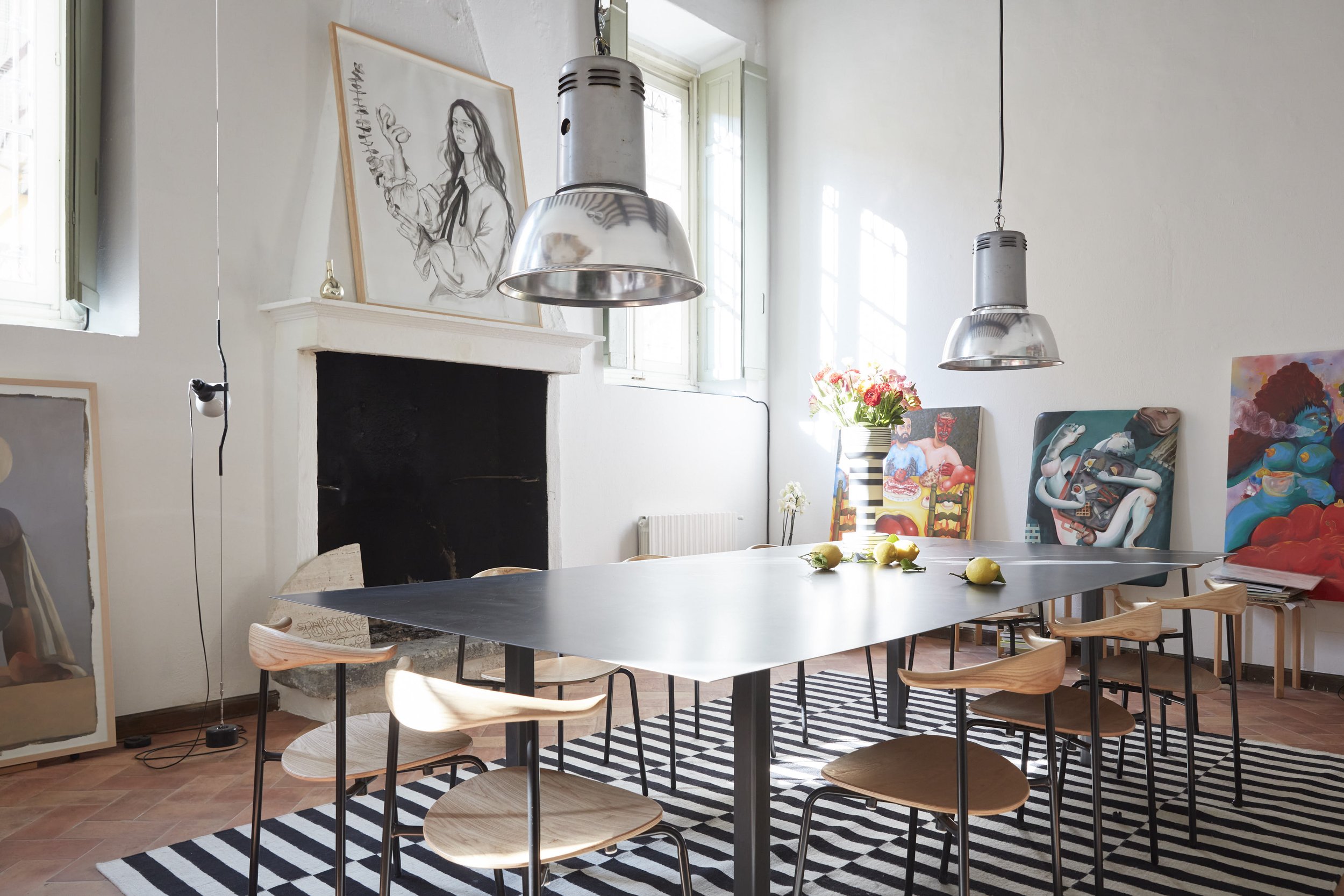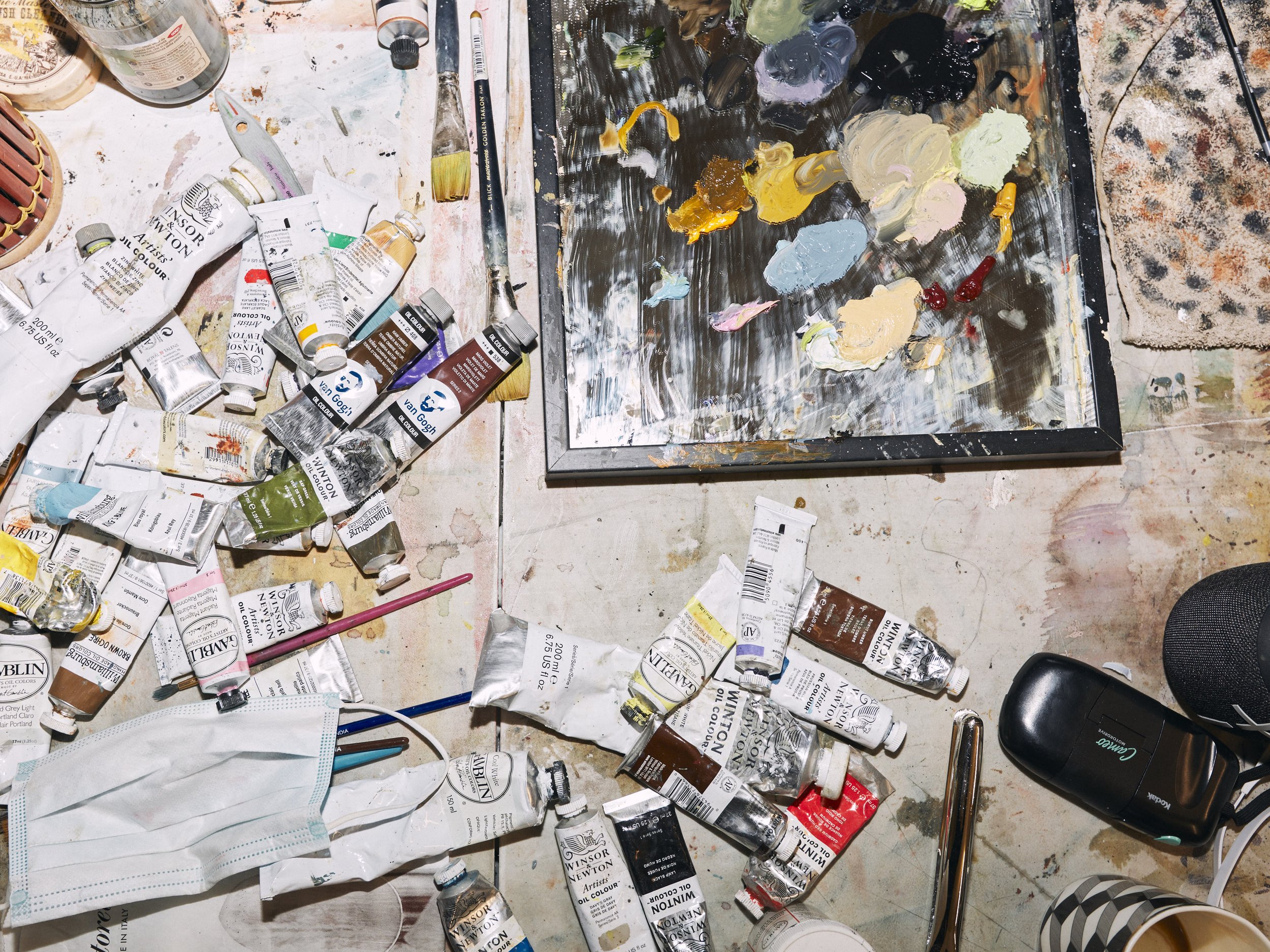interview by Lara Monro
Edoardo Monti is the force of nature behind the Artist Residency, Palazzo Monti. You will find the historical 13th-century palazzo in the Northern Lombardy Region of Italy, in the city of Brescia, halfway between Milan and Verona. Adorned with frescoes from 1750, the palazzo is a unique, utopian space that was purchased by Edoardo’s grandfather in the 1960s. It brings to mind a real life master’s painting, emulating Baroque grandeur paired with a splash of contemporary design and artistic influence.
Monti’s penchant for collecting art began at the ripe age of fourteen. With a modest budget and keen eye, he began making connections in the Italian art world, initially with local galleries and artists. This passion has continued to evolve, as has his taste. In 2017, after a decade of working in fashion for Stella McCartney, Monti turned his dream vision into a reality: an artist residency, which captures the imagination of a new generation of artists and champions a dialogue between the past, present, and future.
Every year, Monti invites three international artists to stay for 4 - 6 weeks at a time. Since 2017, over 200 artists, including Cristina BanBan, Somaya Critchlow, Charlotte Edey, and Henry Hussey have attended Palazzo Monti.
As the residency’s reputation continues to grow within the international contemporary art world, so does the fierce competition for places, with over 400 applications per month; not to mention the impressive board members and honorary directors, which includes the founder of Great Women Artists Katy Hessel.
The palazzo’s aesthetic, its connection to Italy’s Renaissance and the desirable location are enough to convince us that it is the preeminent utopia when it comes to artist residencies. I spoke with Edoardo to learn more about his journey with the palazzo and to understand in more detail his personal definition of utopia, and how he connects this to the palazzo Monti Artist Residency.
LARA MONRO: Do you see the Palazzo Monti Residency as a utopia?
EDOARDO MONTI: I know that I live in a beautiful and lavish palazzo, but I am a very down to earth person! What really interests me is the production aspect, what's behind a piece of art, which can be quite complex, but also very rewarding once you become aware of the whole process. The reason why I'm saying this is because a couple of years ago I curated a show in Brussels called Hétérotopie. This is a term coined by the French writer and philosopher Michel Foucault. It is an alternative model of utopia defined by the spaces that we live in. It describes certain cultural, institutional and discursive spaces that are somehow 'other': disturbing, intense, incompatible, contradictory or transforming.
I like this approach to defining utopia as I feel it is more down to earth. It highlights spaces within the world that we exist in yet these spaces have different rules that you can only make sense of if you live within the spaces. I would like to insert this concept to the residency, and in particular, parts of the palazzo to this style of utopia—a physical utopian space.
That said, in some ways, the palazzo also carries traditional connotations of being a utopia. It's not a dream world that I aspire to live in, but I have the luck to be present in this particular utopian world every day. It's a building that's been around for 800 years that has decorated and adapted over the centuries with style, passion, and love. Think of all the families who have been here and the memories that have been made. It has a very positive energy. Apart from a hotel, who houses creatives for a month at a time? It fits this notion of being a very special world with its own rules. There's rooms for sleeping, there's rooms for working, there's communal areas, there's a communal kitchen. The balance that's created throughout the palazzo changes every month because the residency is built on a program that allows for artists, to check in, connect creatively, and then check out. And then it happens, again and again, over and over. For me, this idea of utopia is directed towards making this physical project the best it can be—continuing to grow it and offer a positive environment where creatives can flourish.
MONRO: Can you tell me about your artist selection process?
MONTI: We have an executive board and also an honorary board of directors. The executives are based in London, New York, Paris and Korea. Between us, we go through a selection process. This includes meeting artists in person or traveling. As a team we speak almost on a daily basis. We do lots of research. Every three months, we meet online to go through the applications. We have a very hands-on approach.
In 2021, we established an honorary board of directors. We looked into the archetypes of the main figures that feature in the creative world; the collector, the curator, the gallery professional, designers. The role of the honorary director is to mentor one artist of their choice per year. It's a great opportunity for the artists to ask questions about the market, curatorial direction, and so on.
MONRO: You want to provide the artist with a sense of liberty in the way you curate the palazzo’s interior. Can you tell us a bit more about this?
MONTI: There are three main design strands; my grandparents pieces; I’m sitting at my grandfather’s desk as we speak and the bar that we have, a corner bar, is also from my grandparents. So, we have items that come from the family. Then, we have pieces that were simply acquired out of need; lighting features or tables, beds, and so on. The third strand is either commissions from resident designers or artists creating something specifically for the space. Because of this, the palazzo has been evolving over the years. Nothing is fixed—we are flexible and able to move most things around in the palazzo which gives a great sense of freedom for the artists who want to create something here. It is a very dynamic space.
MONRO: Are there are any common threads that run through the work of the residents?
MONTI: I mean, we intentionally promote complete liberty for the artist to either continue their practice or explore new mediums, or continue with their existing medium but in a new/different way. I think that's part of the beauty because we don't sell the works, we're not a gallery or a museum. So, this leaves complete, free reign for the artists to fully delve into and express their creativity. There are a few recurring elements. I’ve had a dog for the past three years and sometimes she pops up in the paintings. I myself sometimes appear in works also. The sky is definitely a great influence. All of the studios are facing west, which is where the sun sets. There's a lot of beautiful sunset colors in many of the paintings and sculptures. So, without anything being forced, there is definitely a lot of inspiration coming from the palazzo and surrounding areas.
MONRO: You began collecting art at the age of fourteen, what sort of art were you interested in then, and do you still have a similar taste now?
MONTI: I was very young and I had a very small budget, so I would acquire small prints or various small paintings. Owning multiple small works taught me a lot. Having a chance to see and appreciate the works you have acquired on your wall is priceless. I don't come from a family of collectors. I was the first one to start this passion/obsession. I was doing small jobs while at high school to earn some money, which allowed me to create a relationship with some local galleries and artists. I would say I was consistent in my taste in that I always went for figurative sculpture and I think this has somewhat stayed the same as I am still fascinated by the human figure. It's very cute looking back at what I collected at the beginning and comparing it to what I've been collecting over the past years. It’s interesting, and hugely personal to see how my eye and interests have evolved.






